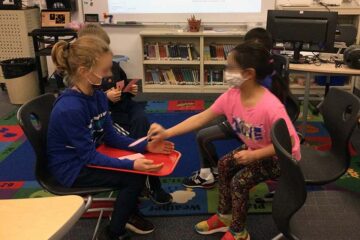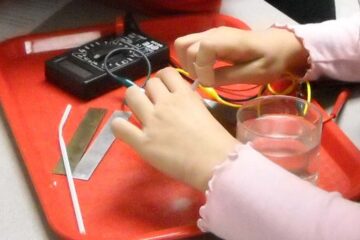What makes for a successful after-school science activity? How to maintain engagement of young kids? How to keep things running smoothly? This post details an experience-tested framework and advice for planning and running a successful science activity for kids.
Time Budget
One hour plus ten minutes for gathering is a good choice for elementary school students in an after school club setting. With older students you could extend the activity time, and always plan for a discussion at the end.
| Stage | Time Allotted |
|---|---|
| Preparation | Depends on the activity |
| Gathering Time | 10 minutes |
| Introduction | 10 minutes (maximum) |
| Activity | 40-50 minutes |
| Post-activity Discussion | 0-10 minutes |
| Clean-up | Depends on the activity |
Preparation Before the Meeting Day
Add instructions to name tags as needed such as dividing children into groups, or station rotation order.
Prepare the supplies for activities, separate trays for each station, or one tray per group of students.
Send your volunteers an overview of the day’s activity. Prepare detailed instructions for them to use during the meeting.

Gathering Time
Assign volunteers to stations so they can familiarize themselves with what they’ll be doing.
Help children find their name tags and stow coats and backpacks.
Suggest that children make trips to the bathroom or drinking fountain.
Introduction
Always keep in mind that your students want to do science and engineering activities, not watch demonstrations and or listen to lectures. The introduction can include slide shows or demonstrations. This may include:
- Historical background
- Technique(s) they will use for the activity
- Questions to be answered/concepts to be explored
- Discussion of results from a previous activity
- One or two scientific principles that will be investigated
For a one hour meeting spend no more than ten minutes introducing and explaining the activity.
During the Meeting
Recruit enough volunteers so you are free to supervise the overall meeting. Be available to provide an extra pair of hands where required, repair a piece of equipment, respond to mishaps, or manage any behavior issues. Avoid being in charge of a single station, or particular tasks that you could not quickly hand off to another person.

Discussion
With many activities you’ll probably find that the children are still eagerly involved when time is up so you can skip trying to gather everyone together again for a discussion. Sometimes you can save this for the next meeting, especially if you discover something interesting when reviewing the children’s results after the meeting.
Other activities require that groups of students compare results. In that case be ready to stop the activity in time to gather the students again.
Clean-up
It’s likely that the students will leave promptly after the meeting. Collect name lanyards as children leave the meeting space. If some of your volunteers can stay a bit longer to help you clean up ask them to sort reusable supplies onto trays, collect data sheets you want to review later, and discard materials no longer needed.



0 Comments